


 |
May 12-15, 1994: A Weekend in North Carolina |
 |
April 30 - May 2, 1994: A Weekend in Austin |
 |
Return to the Index for 1994 |
During the week of May 9, I had a trip to Washington to the STAR '94 Testing Conference. I arrived on Sunday evening, and stayed through Thursday noon. The conference itself was kind of boring, although I did collect a good deal of information that I might be able to use in my testing modifications to Navigator. One afternoon, there were no sessions that I needed to attend, so I went off on my own to wander around Washington- a place I haven't been to in a few years. I went to some of my favorite museums and did a couple of touristy things that I've done before, so the pictures today are a bit eclectic- not a part of some extensive, mapped-out tour.
The Smithsonian
 |
On this Wednesday afternoon, I left the conference, being held at a large hotel out in Arlington, and drove into the District, finding a parking space just off Independence Avenue. I walked passed the Department of Agriculture building and alongside the south side of the street, looking across at the row of Smithsonian buildings on the north side of the avenue.
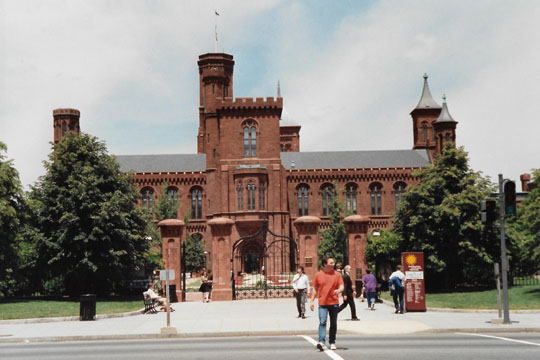 Freer Gallery of Art The Freer gallery was founded by Detroit railroad-car manufacturer and self-taught connoisseur Charles Lang Freer. He owned the largest collection of works by American artist James McNeill Whistler and became a patron of the Smithsonian, funding the construction of the gallery in 1921. |
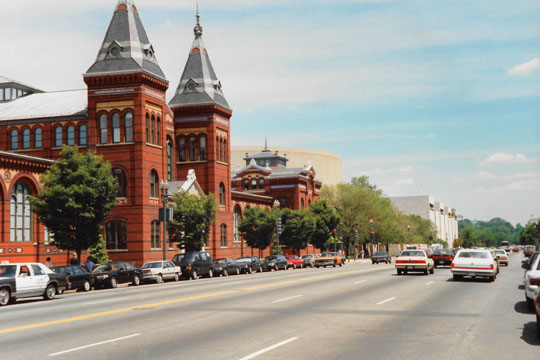 Arts and Industries Building In this view, looking towards the Capitol, you can see the Arts and Industries Building. Beyond that there is an open space where the Hirschorn Museum is and, further down the street, the white marble facade of the relatively new Air and Space Museum (the last white building on the left down the avenue). |
The one museum I wanted to visit this afternoon was the National Air & Space Museum. This Smithsonian Museum is a 160,000-square-foot building that holds the largest collection of historic aircraft and spacecraft in the world. It was established in 1946 as the National Air Museum and opened its main building near L'Enfant Plaza in 1976. It is one of the top ten most visited museums in the world.
|
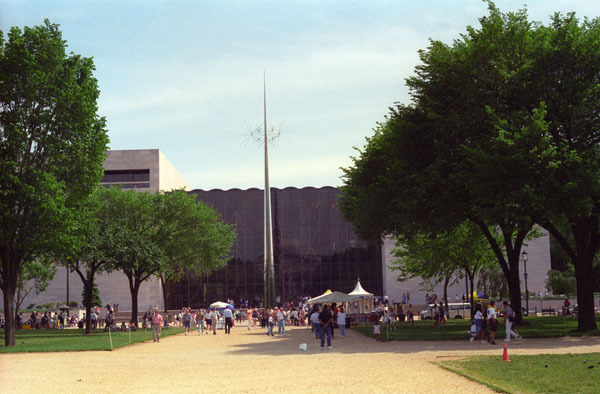 |
The National Air and Space Museum is a center for research into the history and science of aviation and spaceflight, as well as planetary science and terrestrial geology and geophysics. Almost all space and aircraft on display are originals or backups to the originals.
The National Mall
 |
Above, you can see an aerial view of the National Mall, and I have marked some of the main features in and around it. One of the features was not actually present today; it would not be constructed for another ten years. Of course, I am referring to the National World War II Memorial. From the Air and Space Museum, I walked out onto the Mall to take my first pictures.
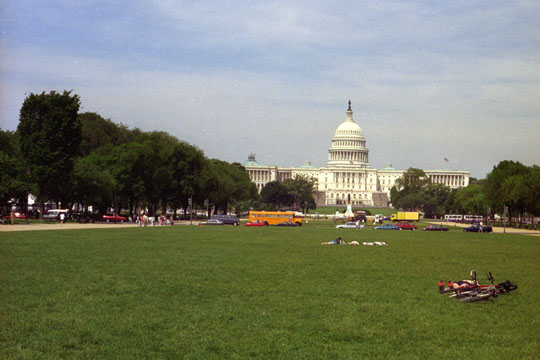 The Capitol from the National Mall Out in the center of the Mall I took this picture of the Capitol Building some four blocks away. |
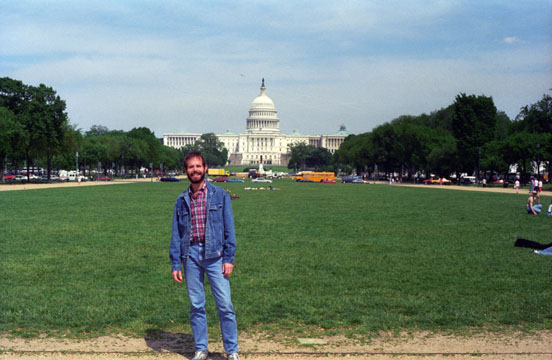 Me on the Mall with the Capitol in the Background As I walked down the Mall (actually walking west), I quickly realized that I needed to get in some of my own photos. Not carrying a tripod with me, I had to rely on the kindness of strangers. |
I continued walking a bit more west along the mall, until I came abreast of the Old Smithsonian Building. Here, I stopped to take a couple more pictures.
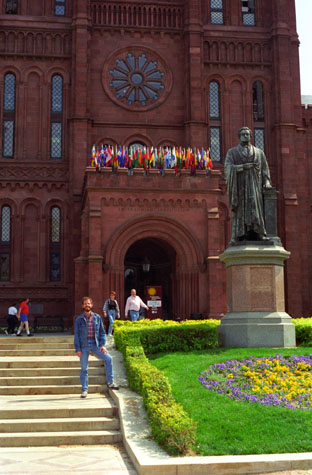 The Smithsonian Institution Building |
(Picture at left) Here, I thought the contrast of the old building, the flags, the statue (of Joseph Henry, the first Secretary of the Smithsonian Institution) and the plantings offered an interesting view.
(Picture at right)
|
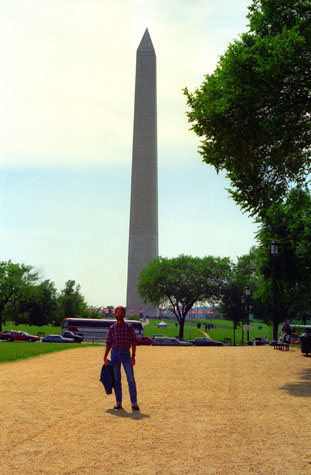 The Washington Monument from the Mall |
I continued walking west along the National Mall, enjoying the afternoon sunshine with the tourists and locals who are ubiquitous here on the Mall 365 days a year. Not many this afternoon, certainly, which made a quick trip up the Washington Monument feasible.
|
The last time I was here in Washington, which was with Grant some years ago, we went up into the Monument to get some pictures, many of which, I recall, did not turn out well, so I thought that I would go up and try to get some better shots today. I only hoped that the wait time to go up into the Monument wouldn't be too long.
By now I was getting fairly close to the Monument, and I could see that the crowd waiting to go up was fairly small, so I made the decision to make the trip up to the top.
The Washington Monument
|
Construction of the monument began in 1848, but was halted from 1854 to 1877 due to a lack of funds, a struggle for control over the Washington National Monument Society, and the intervention of the American Civil War. Although the stone structure was completed in 1884, internal ironwork, the knoll, and other finishing touches were not completed until 1888. A difference in shading of the marble, visible approximately 150 feet or 27% up, shows where construction was halted and later resumed with marble from a different source.
The original design was by Robert Mills, a prominent architect during first half of the 19th century, but he suspended his colonnade, proceeding only with his obelisk, whose flat top was altered to a pointed marble pyramidion in 1884. The cornerstone was laid on July 4, 1848; the first stone at the 152-foot level was laid August 7, 1880, the capstone was set on December 6, 1884, and the completed monument was dedicated on February 21, 1885. It officially opened October 9, 1888.
Upon completion, it became the world's tallest structure, a title previously held by the Cologne Cathedral. The monument held this designation until 1889, when the Eiffel Tower was completed in Paris, France.
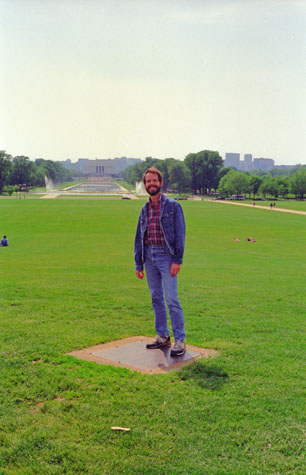 The View Towards the Lincoln Memorial |
(Picture at left) The wait to go up in the Monument was about an hour, so there was plenty of time to look around. As the line moved to the back of the Monument, I saw this view, and had one of the other people in line take this picture for me. Here I am on the west of the monument, and behind me are the Reflecting Pool and the Lincoln Memorial.
(Picture at right)
|
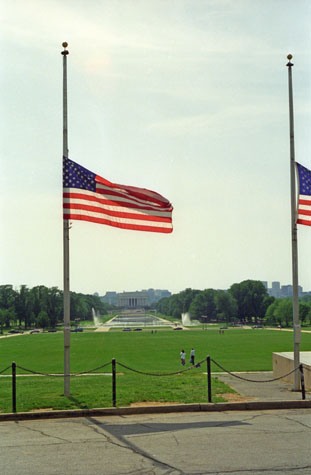 The Flags at Half-Staff |
When it came my turn to go into the Monument, I found that the stairs were closed- permanently. I climbed to the top of the Monument on a visit to Washington in 1969 when I was stationed at Fort Lee, Virginia. I drove up one weekend and did many of the touristy things. (Not the Air & Space Museum, though; I didn't visit that until 1980- three years after it opened.) In 1971, the stairs were closed to people climbing up, although you could still walk down them. However, in 1976, they were closed to the public permanently- supposedly because of the number of accidents and heart attacks suffered by climbers. So this afternoon, it was the 90-second elevator ride.
I took a number of good pictures out the small windows at the top of the monument, and some of them are below:
|
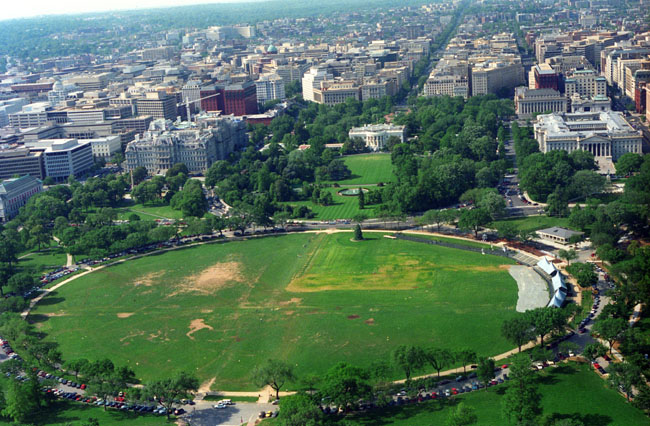 |
The view above looks north at the Ellipse and the White House and much of downtown Washington. In the center you can see the White House and the South Lawn. At the left is the Executive Office building, and in the near ground is the Ellipse (around which Clinton does some of his jogging). The rest of the view is taken up by the city of Washington, and the picture looks north into Maryland.
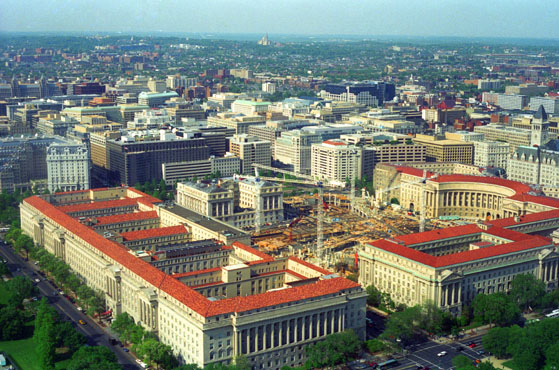 The Commerce and Justice Departments In the background is more of the city of Washington. This view looks northeast towards Baltimore. |
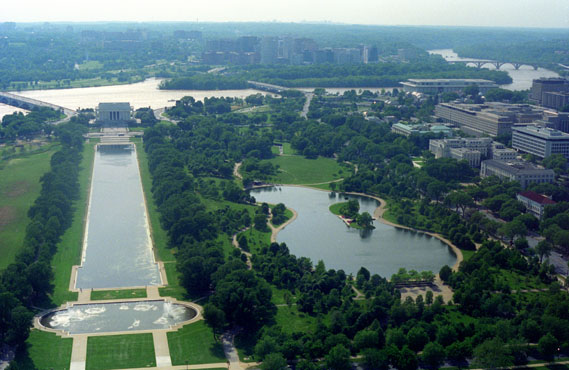 The View to the West At right is part of the Department of Defense, and west of them along the Potomac is the Kennedy Center. That's Arlington across the river. Somewhere in those buildings is the Key Bridge Marriott, where I stayed during the week in 1974 that I joined Cullinane Corporation. You can see the Reflecting Pool and the Lincoln Memorial, and the bridge across the Potomac to Arlington Cemetery. |
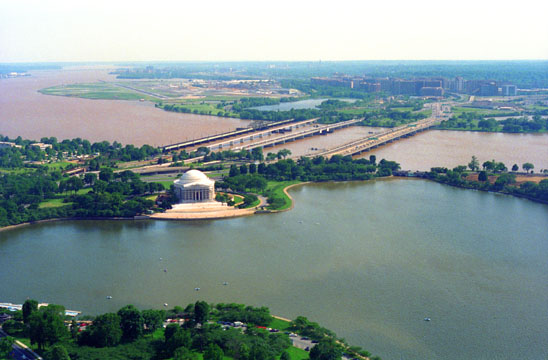 The View to the Southwest The Boat Basin and the Potomac, with the Jefferson Memorial right in the center. You can see also both the Fourteenth Street Bridge and the I-395 Bridge across the Potomac. Across the bridges to the right is Crystal City (actually part of Arlington). The District ends at the Potomac, so that is Virginia. You can see National Airport also, and beyond that the city of Alexandria, where I have stayed frequently. |
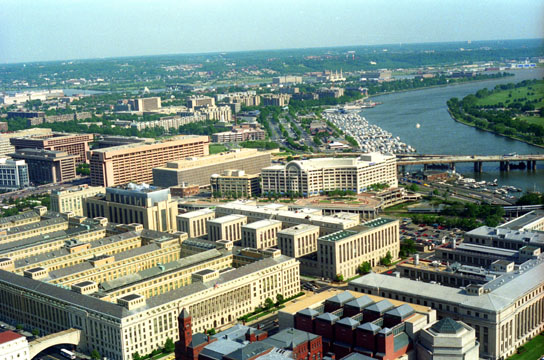 The View to the South Here you can see the Washington Yacht Basin at the right. The old Government Printing Office is at the bottom of the picture. Interior and Agriculture are in the large complex in the foreground. Beyond that is the beginning of L'Enfant Plaza, which houses a number of smaller agencies. In the distance (in Maryland) is Andrews Air Force Base. |
After visiting the Monument, I went back to the car, only to find that I had parked in a zone that was only metered until four p.m., and consequently I had a $50 ticket on it. I drove back out into Virginia to the hotel, where we had our closing banquet that evening. The entire conference was just satisfactory- nothing outstanding.
Now the the conference is over, I am going to work in a short trip down to North Carolina on my way home to Dallas.
You can use the links below to continue to another photo album page.
 |
May 12-15, 1994: A Weekend in North Carolina |
 |
April 30 - May 2, 1994: A Weekend in Austin |
 |
Return to the Index for 1994 |